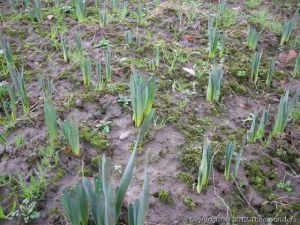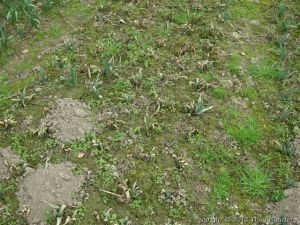The first picture shows Symptom at January 13. We had very high temperatures in winter during December and January in Essen (Germany). The leafs of many daffodils were already very long when a period of two weeks of hard frost in February,up to – 14 degrees C without snow, followed. The conseqences you see in picture two. No plant of Symptom will recover. I lost a big part of my daffodils this year because of this abnormal climatic conditions. I observed daffodils during nearly 40 years and lost no plant by frost. I could leave bulbs out of the soil or in pots outside and had no damage.
The positive aspect of the situation is that I can learn which varieties are most resistant to long periods of frost within the soil. I already can say, that most Y-R varieties were killed and most of the Y-P daffodils showed no damage. Crosses of standard daffodils with species behave very different and sometimes surprising: for example most bulbs of Ufo x N. dubius are living with damaged leaf. I shall give further detailed information to daffnet when I can overlook the whole situation.
To judge the frost resistance of daffodils one could us a freezer which a special program, which simulates for example the temperatures of this winter in Essen. It would not be as effective as trials at different sites but cheaper and the results we could have earlier. It is quite clear, that tests of other characteristics of daffodils at different sites would be very useful.
Theo



2 comments for “Test of daffodils at different localities”